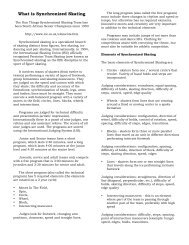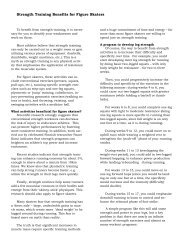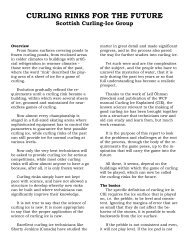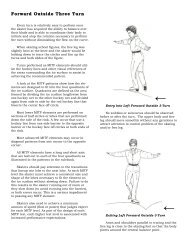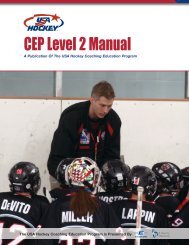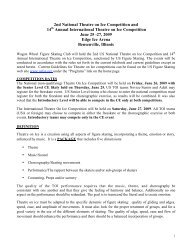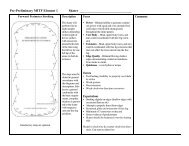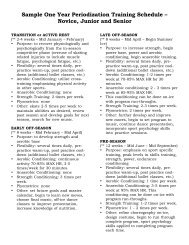CEP Level 3 Manual - Rushmore Hockey Association
CEP Level 3 Manual - Rushmore Hockey Association
CEP Level 3 Manual - Rushmore Hockey Association
You also want an ePaper? Increase the reach of your titles
YUMPU automatically turns print PDFs into web optimized ePapers that Google loves.
T A B L E O F C O N T E N T SCOACHING IMPLICATIONSEmpathize with your athletes. Put yourself intheir place and view events from the players’ pointof view.• Remember that your actions and commentshave a significant influence on the psychosocialdevelopment of these young athletes.• Use positive reinforcement anddemonstrate appropriate behavior (e.g.,good sportsmanship).• Do not “fly off the handle” if a playerdisplays an inappropriate behavior out offrustration. Try to understand that theathlete is passing through a stage of rapidphysical and psychological development.Certain outbursts due to frustration shouldbe expected.• Provide clear and meaningful explanationsof your decisions as early adolescents aredeveloping the ability to reason and mayquestion certain requests.• Goal-setting should be limited primarily toshort-term goals (e.g., learning to stop or toturn).• Players in the early adolescent period willrespond well if they are given someresponsibility and the opportunity toparticipate in goal-setting.MIDDLE ADOLESCENCE (14–16 YEARS)Key Features• The rate of physical growth is much lessdramatic than in early adolescence.• Body systems are beginning to mature andthe athletes are acquiring greater strength,endurance, and coordination.• Thought process is more sophisticated. Themiddle adolescent is able to think in both anabstract and an analytical manner.• Players pass through a period of self-analysiswhich may lead to self criticism and selfdoubt.As a result, many 14, 15 and 16 yearolds drop out of hockey.• This period is difficult for young athletes asthe heightened awareness of the gapbetween “who they are” (real selves) and“who they would like to be” (ideal selves)may cause feelings of frustration and failure.• Middle adolescence is also marked by thedesire to experience new events life (e.g.,drugs, alcohol, cars, other sports, choosingclose friends, and establishing meaningfulrelationships).• Conflicts with authority figures, (e.g.,coaches, referees, and parents) may occurduring this period.• Actions and comments of coaches, parents,and significant others can have a majorinfluence on the types of attitudes, values,and dispositions athletes acquire withrespect to these individuals and sport ingeneral.COACHING IMPLICATIONSSince middle adolescents are passing through aperiod of self–analysis, you can be helpful byattentively listening to each player’s concerns.• Regular informal conversations with athletesshould be used to help identify realisticfuture goals and the means to attain them. Inso doing, athletes become more award oftheir “real” selves. This avoids problemswhich can arise due to an “ideal” selfconceptualization.• Be aware of the social influences on yourathletes (e.g., drugs, and alcohol).• Provide players with more detailedexplanations and rationales when teachingskills, tactics, and systems.• Strength and endurance will increasesignificantly for athletes who followintensive training programs.• The late adolescent spends a lot of timeestablishing a value system with norms,values, and beliefs that they intend to live by.• The athlete’s personality is now quite firmlydeveloped and strong feeling ofindependence exist.• In the players’ attempts to fulfill their needsfor independence, certain confrontationsmay occur with significant others (e.g.,parents, coaches, and teachers).COACHING IMPLICATIONS• Recognize the importance of your athletes’needs for independence and personalresponsibility.• As some athletes become heavily involvedin weight training programs to increase theirstrength, you should remind them of theimportance of flexibility exercises. Also,reinforce the need for a thorough nutritionalplan.• Ask players to run part of the practicesessions, participate in establishing teampolicies, and, in general, experience varioustypes of independent and responsibleactivities.• Ensure that all players understand thesignificant roles they play on the team.• For late adolescents you can become arespected counselor who assists the athletesin establishing their value systems.• Work together with your players to developchallenging goals which can be achievedthrough highly specialized trainingprograms.FOR THE COACHIn what growth and development stage are yourpresent athletes in? List what you consider to be thethree most important characteristics of theirdevelopment. Design specific guidelines to meetthe needs of your players.State of development:________________________________________Three most important characteristics:________________________________________________________________________________________________________________________Specific guideline:________________________________________________________________________________________________________________________________________________________________________________________________________SUMMARYThe goal is to establish an effective coachathleterelationship and to maximize satisfaction foreach player. To do so, coaches must take intoconsideration the level of each athlete’s physical,mental, social, and emotional development. Alwaysremember these four important points:• Each athlete is unique and, therefore, eachwill mature at a different rate.• For each athlete, the four areas ofdevelopment will mature at different rates.• Each player is an adolescent first and anathlete second.• Design guidelines to meet thedevelopmental needs of your players.• Middle adolescents become more willing tounderstand and even accept anotherindividual’s point of view.LATE ADOLESCENCE (17–19 YEARS)Key Features• Athletes become more aware of theirphysical potential and limitations.• Except for the late maturers, there is limitedphysical growth.88 | USA <strong>Hockey</strong> Coaching Education Program <strong>Level</strong> 3 <strong>Manual</strong>Sport Psychology | 89



